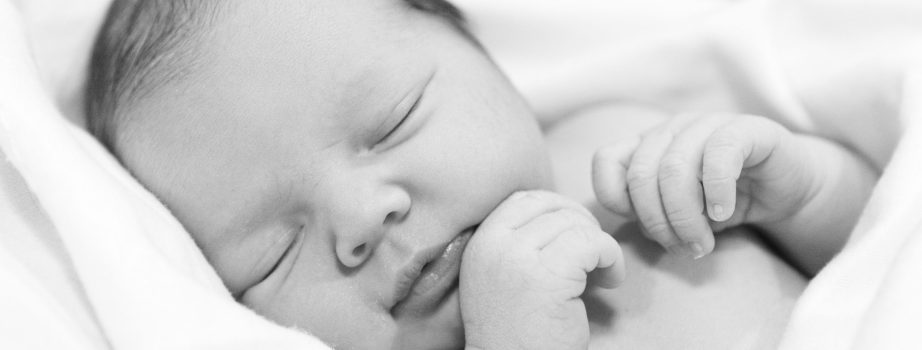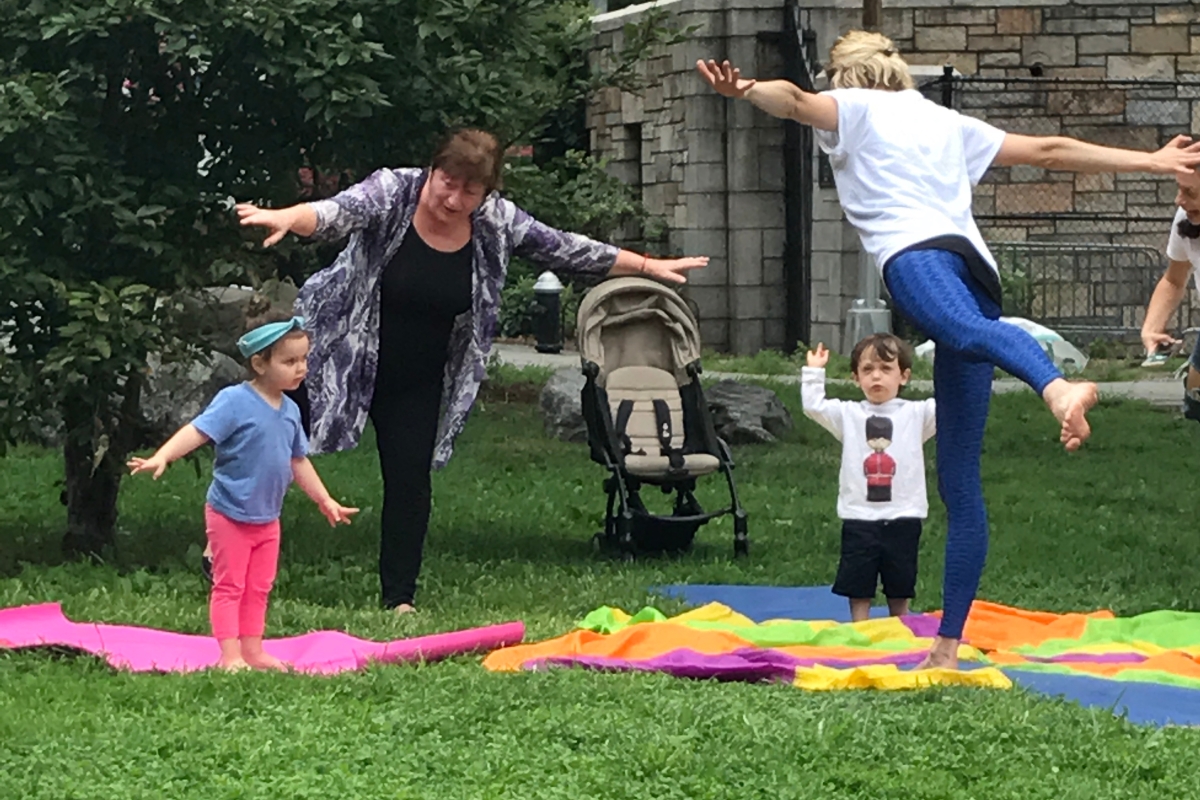
Have you guys heard of yoga for hearing loss? When Sabine Hobbel learned her son Aidan, now five, was born with hearing loss, she looked to yoga as one way to help him. Sabine created Little Light Yoga and Movement, an online yoga program for kids with hearing loss between the ages of four to eight years.
“Hearing loss isn’t just about the ears,” she told me in a recent video call (Sabine lives in Milan, Italy). “There are so many areas impacted: balance, fine and gross motor skills, focus and attention, reading skills and eye strength as well as self esteem. These are all areas that can be improved through yoga.”
Sabine, a former elite field hockey player in the Netherlands and Australia, turned to the healing properties of yoga after years of the sport took its toll on her body. She was certified as an instructor in 2017.
“While I mostly practice Hatha yoga, I adapt it for kids,” she says. Sometimes parents imagine this zen environment — which seems unrealistic for young children — but this is not my yoga. During my sessions there is a lot of laughter, jumping and being silly. I don’t care about perfection. Rather, we focus on breathing and what is happening in our bodies. It doesn’t matter how flexible your little one is or their body type. Yoga is for everyone.
“If you present yoga in a fun way, kids are happy to do it and the benefits will come without them realizing it. ” – Sabine Hobbel
What does yoga for hearing loss look like? Check out Sabine’s favorite yoga poses below: NB: Before starting, as with any physical activity, make sure your child feels warm enough to start some yoga. Dancing to their favorite song, star jumps or running on the spot are great ways to warm up.
Crab Pose: Great for gross motor, balance and focus
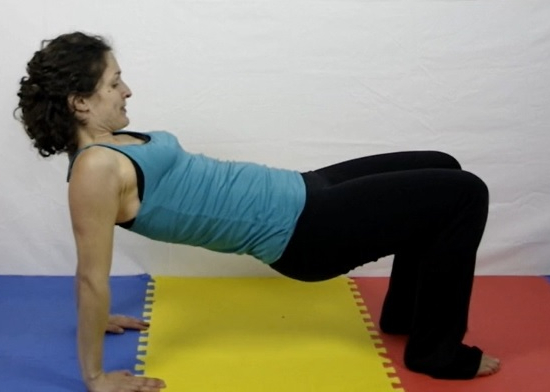
Invite your child to sit down on the ground on their bottom; palms of hands flat on the ground on either side next to their bottom, fingers pointing toward the toes. Feet are flat on the ground, knees are bent. Whenever your child is ready, let them push off slowly into hands and feet, lifting the bottom as far up as feels right. The neck can be relaxed or they can look toward their toes. Eyes can be open or closed, whichever feels right. Allow your child to come out of the pose when it is right for them in the exact, slow manner as they came into it.
What will my child look like doing this?: Most kids will look like an “M” when viewed from the side, with their bottom hovering close to the ground. Some children will manage to lift up their bottom very high, making a 90 degree angle in the knee and in the shoulder joint, looking almost like a table. Other children won’t have the strength to lift their bottom up, but their body is still working hard in the attempt to do so. All versions are right and a cause for celebration. Allow your child to explore in the way that feels right for them.
Additional challenge: If it feels right today, walk while in crab pose. This takes a lot of extra strength, balance and focus. Applaud any attempt, no matter the outcome. As always, communicate so that your child has the best possibilities of understanding you (e.g. use their FM, tap them first, make sure your mouth is visible, etc.).
Candle Breath: Great for focus, fine motor skills, emotional regulation
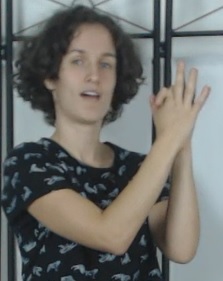
Depending on your child’s current level of tiredness, you can sit either in criss cross apple sauce (or similar) or remain standing. Hands are flat and palms are placed together, about one hand distance away from the mouth. We’re pretending that we’ve got five different candles right in front of us on a birthday cake. It’s a special cake, and the candles can only go out one at the time, and only if we take nice deep breaths in and out. After the first deep inhale and exhale, fold the thumbs over each other and say “one”. The next deep inhale and exhale, fold the index fingers while saying “two”, and so on until all five candles have been blown out.
What will my child look like doing this?: Most kids are calm while they attempt this activity. Many need some modeling initially of how to fold the fingers, especially once you reach the ring and pinky fingers. Some children will close their eyes while they breathe, this is fine. Some children will need a reminder that only deep breaths will work on these special candles, rushing to blow out the candles will actually not count for this activity (and will not help them to feel calm). There are some children for whom this is a hard activity as they get fidgety. Allow those children to stand while they try this pose. You might be surprised that after trying this pose for a number of consecutive days, they will be able to stay calmer and less wiggly for the duration of the exercise.
Additional challenge: Let your child blow out the number of candles for their next birthday, so that an eight-year-old will have to blow out nine candles. I generally don’t recommend including more than 15 candles in any one session, as this is a lot for most children, but you know your child best.
Pro tip: Tell your child that it can be a great idea to blow out candles whenever they face a tricky situation, as it can help them stay calm and in control. Real life examples include: when asked to share a favorite toy with a sibling; when asked to stop playing video games; and before wax removal at the doctor’s office.
Flamingo pose: Great for balance, gross motor, focus
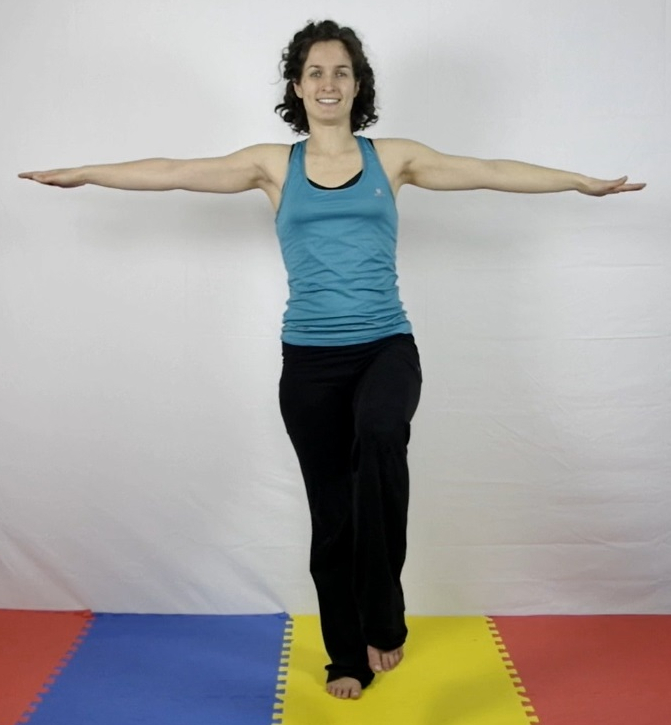
For this pose, stand up tall on two legs. We’re going to balance on one leg just like a flamingo, so shift your weight onto one foot. Your child can have their arms outstretched to the sides for extra balance. Remind them that they can always place the feet back on the ground to feel stable again. Now slowly let them lift up their leg and foot of the leg towards the front, so that the knee bends in front of them. When they’re done, have them place their feet flat on the ground again.
What will my child look like doing this? Most children look very wobbly when first attempting this, and that is absolutely fine. Remind them that it is ok to step back on the ground when they feel like the balance is out of control. Most children will be able to lift their foot somewhat. Other options include keeping the toes of the foot that needs to be lifted on the ground, or initially holding on to the adults hand when trying this. Some children will attempt to lift their foot very high, nearly reaching a ninety degree angle of their knee, or they might get their knee up even higher. As always, all versions of the pose are worthy of celebration, we’re not looking for a specific outcome, the practice is all that matters. This pose challenges their abdominal and leg strength in whatever version your child tries it. To try to stand still without falling means that they are very focused and using their balance skills.
Additional challenge: If your child feels stable while standing like this, let them move their arms like flamingo wings! Some children will like to hold hands while attempting this, that is fine too.
Pro tip: Tell your child that it gets easier to maintain their balance if they focus on one, unmoving spot on the wall or floor. Once your child is not wobbling anymore, invite them to feel their breathing in their body.
London Bridge: Great for focus, balance, gross motor skills, eye strength

Let your child lie down on their back, with their feet as close to their bottoms as possible. Feet should lie flat on the ground with the knees bent. Then, have your child lift their bottom up as high as possible, so that only their head, neck, shoulders, arms and feet are touching the ground. The back, legs and bottom are all up in the air. Your child is going to move to the song “London Bridge” which you can sing or find online. Every time they hear the word “down,” it is time to move the body downwards, and immediately up again. Some children can lie flat on the ground, others just move slightly down and up. Whatever is possible, is right today.
What will my child look like doing this?: Your child will have their bottom lifted as far as feels comfortable. Some children will still touch the ground with their bodies even when they have their bottom lifted due to body size and fitness levels. That is ok, just as any child who is able to lift their lower body completely in the air. Most kids will tire out before the song is over and will be less active towards the end of it, others will be able to complete the song easily. All versions are fine. Many kids will giggle during this silly version of London Bridge.
Additional challenge: If your child completes this song easily, see if they can do the same with one foot lifted in the air! This means that they are balancing just on one leg while lowering themselves and lifting themselves up again.
Easy Relaxation: Great for focus, emotional regulation

Invite your child to lie flat on their back or belly, whatever feels right at that moment. If your child can understand you with their eyes closed, they can close their eyes straight away, if desired. If not, explain what you’ll do before they are allowed to close their eyes. Explain to them that we are pretending to be ice cream melting in the sunshine. So we’re going to become really aware of the different body parts (you can name or touch them gently, starting from the feet), allowing them to become very heavy, still and ‘melting’ into the ground. Go at the pace your child enjoys, some children can relax like this initially only for a few seconds, others can go up to five minutes and enjoy this blissful state of calm. You can see what feels right for your child today, do not force anything. Longer is not better if it doesn’t feel right. Whenever you feel your child has relaxed for long enough or is unable to continue for whatever reason invite them to roll onto their sides, slowly sit up and take a deep breath in this sitting position showing a big smile if that feels right. Yoga is finished for today!
What will my child look like while doing this?: Many children feel calm in this pose. About half enjoy closing their eyes, the other half prefer eyes open. That’s all fine. Some children with tight hamstrings will not enjoy having their legs long, but will bend their knees, that is absolutely ok. Many children will automatically move to belly breathing in this pose (also unprompted): showing an inflated belly when inhaling, and deflating it when exhaling.
Pro tip: Tell your child that it is great to think about melting ice-cream when trying to fall asleep at night.
Looking for more? Sabine has created three online yoga programs for parents to consider:
Sound of a Smile: This online course was developed for children with hearing loss, ideally targeting kids between the ages of four and eight years, the course runs eight weeks and can be found here. Cost: €56.
Yoga for Resilience: This unique course can be enjoyed in two ways: (1) Children can do yoga with the videos Sabine made for them. If desired, parents can choose to watch the explainer videos, which explain why the course is structured in this way. (2) For parents who want the benefit of yoga without the screen time, Sabine has developed videos that teach the parents exactly what the moves are for every week, so that parents can act as teachers. In this case, parents do not show the yoga videos to their children. Yoga on Demand runs eight weeks. Cost: €200 for our readers.
Yoga on Demand: Sabine will conduct an intake interview to learn about your child. She will then send two initial video sessions between 20-30 minutes in length for your child to practice (with parents, if desired). In two weeks time, a follow-up call will take place to evaluate progress and make any necessary adjustments after which you will receive one video per week tailor-made for their child. Every two weeks, you have the option to talk to Sabine again, so that changes can be made and new poses can be introduced. The course runs eight weeks and costs €200 for our readers.
To express interest and for this reduced price, email sabine.littlelight@gmail.com and mention “Sonya Rose.”
Thank you, Sabine! Sonya and I can’t wait to do some yoga!
